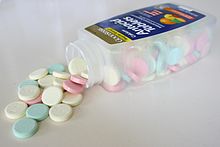제산제
Antacid
제산제는 위산도를 중화시키는 물질로 속쓰림, 소화불량, 배탈 등을 완화시키는 데 사용됩니다.[1] 일부 제산제는 변비와 설사 치료에 사용되었습니다.[2] 시판되는 제산제에는 알루미늄, 칼슘, 마그네슘 또는 나트륨의 염이 포함되어 있습니다.[2] 일부 제제에는 탄산마그네슘 및 수산화알루미늄(예: 하이드로탈사이트)과 같은 두 가지 염의 조합이 포함되어 있습니다.[3]
의료용
제산제는 처방전 없이 구입할 수 있으며 입으로 복용하면 위식도 역류질환과 소화불량의 주요 증상인 가끔 발생하는 속쓰림을 빠르게 완화시켜 줍니다. 제산제 단독 치료는 증상이 있고 경미한 증상에 대해서만 정당화됩니다.[4] 제산제의 대체 용도로는 변비, 설사, 고인산혈증, 요중 알칼리화 등이 있습니다.[2] 일부 제산제는 췌장 기능 부전의 치료에 췌장 효소 대체 요법의 보조제로도 사용됩니다.[5]
비 미립자 제산제(구연산나트륨)는 위 부피에 거의 또는 전혀 영향을 미치지 않으면서 위 pH를 증가시키기 때문에 수술 전 절차에서 일부 제한적으로 사용될 수 있습니다. 구연산나트륨은 수술 후 1시간 이내에 투여해야 가장 효과적입니다.[6]
부작용
2013년 연구에 따르면, 기존의 발포정은 상당한 양의 나트륨을 함유하고 있으며 심혈관계 부작용의 가능성 증가와 관련이 있습니다.[7] 마그네슘염을 함유한 대체 무나트륨 제제는 설사를 유발할 수 있는 반면, 칼슘이나 알루미늄을 함유한 제제는 변비를 유발할 수 있습니다.[8]: Table 2 알루미늄이 함유된 제산제를 장기간 사용하면 골다공증 발병 위험이 높아질 수 있습니다.[9] 시험관 내 연구에서 제산제 과다 사용으로 인해 산이 반동될 가능성이 발견되었지만, 이 발견의 중요성에 의문이 제기되었습니다.[10][11]
제산제의 성질
위에서 과량의 산이 생성되면 위의 안감을 보호하는 자연점막 장벽이 저하되어 통증과 자극을 유발할 수 있습니다.[citation needed] 식도에 통증과 손상을 유발할 수 있는 위산 역류의 발생 가능성도 있습니다.[citation needed] 제산제에는 위산을 화학적으로 중화시키는 알칼리 이온이 함유되어 있어 위내막과 식도의 손상을 줄이고 통증을 완화시켜 줍니다.[1] 일부 제산제는 산 역류로 식도를 손상시킬 수 있는 효소인 펩신을 억제하기도 합니다.[2][12]
제산제는 산 분비를 직접적으로 억제하지 않기 때문에 H수용체2 길항제나 프로톤펌프 억제제와 같은 산 감소제와 구별됩니다.[4] 제산제는 대부분의 궤양을 일으키는 헬리코박터균을 죽이지 않습니다.[4]
상호작용

제산제는 플루오로퀴놀론 및 테트라사이클린 항생제, 철, 이트라코나졸 및 프레드니손을 포함한 여러 경구 약물과 상호 작용하는 것으로 알려져 있습니다.[13] 금속 킬레이트화는 이러한 상호작용의 일부(예: 플루오로퀴놀론, 테트라사이클린)를 담당하여 킬레이트화된 약물의 흡수를 감소시킵니다. 일부 상호작용은 제산제 섭취 후 위에서 관찰된 pH 증가로 인해 약산의 흡수가 증가하고 약염기의 흡수가 감소하기 때문일 수 있습니다.[citation needed] 또한 제산제는 소변의 pH를 증가시켜(알칼리화) 약염기의 혈중 농도를 증가시키고 약산의 배설을 증가시킬 수 있습니다.[14]
약물 흡수에 대한 위산도 및 킬레이트화의 영향을 완화하기 위해 제안된 방법은 상호작용하는 약물과 제산제 투여를 최소 2시간 이상 간격을 두는 것이지만,[15] 이 방법은 소변 알칼리화의 영향을 받는 약물에 대해 잘 연구되지 않았습니다.[13]
지연제정과 제산제의 상호작용에 대한 우려가 있는데, 제산제는 지연제정의 코팅이 녹아버릴 정도로 위의 pH를 높여 pH에 민감할 경우 약물의 분해로 이어질 수 있기 때문입니다.[14]
제형
제산제는 가스를 제어하기 위해 시메티콘, 또는 산에 대한 물리적 장벽으로 작용하기 위해 알긴산과 같은 다른 활성 성분으로 제형화될 수 있습니다.[16]
액체
여러 액상 제산제가 판매되고 있습니다. 일반적인 액체 제제에는 마그네시아 우유와 마그네슘/알루미늄 조합이 포함됩니다. 정제보다 액체 제제를 사용하는 것의 잠재적인 이점은 액체가 더 빠른 완화를 제공할 수 있지만 이는 더 짧은 작용 기간과 일치할 수 있다는 것입니다.[17]
태블릿
씹을 수 있는 정제
씹을 수 있는 정제는 가장 흔한 형태의 제산제 중 하나이며, 가장 자주 탄산염이나 수산화염으로 만들어지며, 카운터에서 쉽게 구할 수 있습니다. 위에 도달하면 가루로 된 제산염이 하이드로늄(H+) 이온과 결합하여 염화염, 이산화탄소 및 물을 생성합니다. 이 과정은 위의 H+ 이온 농도를 감소시켜 pH를 높이고 산을 중화시킵니다.[8]: Figure 1 정제 형태로 제공되는 일반적인 탄산염에는 칼슘, 마그네슘, 알루미늄 및 나트륨이 포함됩니다.[13]
일부 일반적인 미국 브랜드는 Tums, Gaviscon 씹을 수 있는 태블릿 및 Maalox 씹을 수 있는 태블릿입니다.[18]
발포정
발포성 정제는 물에 녹은 다음 이산화탄소를 방출하도록 설계된 정제입니다.[19][20][21] 일반적인 성분으로는 구연산과 중탄산나트륨이 있는데, 이들은 물과 접촉하면 반응하여 이산화탄소를 생성합니다. 발포성 제산제에는 아스피린,[22] 탄산나트륨 또는 타르타르산도 포함되어 있을 수 있습니다.[23] 아스피린이 들어있는 것들은 위 점막에 아스피린의 영향으로 인해 위 자극과 궤양을 더 유발할 수 있습니다.[24]
사회와 문화
이 구간은 확장이 필요합니다. 추가하여 도움을 드릴 수 있습니다. (2024년 1월) |
브랜드명
일부 브랜드에는 알카-셀처, 가비스콘, 툼스, 에노 등이 있습니다.[25][26]
참고문헌
- ^ a b c d Salisbury BH, Terrell JM (2020). "Antacids". StatPearls. Treasure Island (FL): StatPearls Publishing. PMID 30252305. Archived from the original on 5 November 2021. Retrieved 24 November 2020.
- ^ "Aluminum hydroxide and magnesium carbonate Uses, Side Effects & Warnings". Drugs.com. Archived from the original on 20 May 2021. Retrieved 24 November 2020.
- ^ a b c "Consumer Summary – Treatment Options for GERD or Acid Reflux Disease: A Review of the Research for Adults". U.S. Department of Health & Human Services. Agency for Healthcare Research and Quality. 23 September 2011. Archived from the original on 11 October 2014.
- ^ Graham DY (June 1982). "Pancreatic enzyme replacement: the effect of antacids or cimetidine". Digestive Diseases and Sciences. 27 (6): 485–490. doi:10.1007/BF01296725. PMID 6282548. S2CID 10640940.
- ^ Apfelbaum JL, Agarkar M, Connis RT, Coté CJ, Nickinovich DJ, Warner MA, et al. (American Society of Anesthesiologists Committee on Standards and Practice Parameters) (March 2017). "Practice Guidelines for Preoperative Fasting and the Use of Pharmacologic Agents to Reduce the Risk of Pulmonary Aspiration: Application to Healthy Patients Undergoing Elective Procedures: An Updated Report by the American Society of Anesthesiologists Task Force on Preoperative Fasting and the Use of Pharmacologic Agents to Reduce the Risk of Pulmonary Aspiration". Anesthesiology. 126 (3): 376–393. doi:10.1097/ALN.0000000000001452. PMID 28045707.
- ^ George J, Majeed W, Mackenzie IS, Macdonald TM, Wei L (November 2013). "Association between cardiovascular events and sodium-containing effervescent, dispersible, and soluble drugs: nested case-control study". BMJ. 347: f6954. doi:10.1136/bmj.f6954. PMC 3898660. PMID 24284017.
- ^ a b Garg V, Narang P, Taneja R (March 2022). "Antacids revisited: review on contemporary facts and relevance for self-management". The Journal of International Medical Research. 50 (3): 3000605221086457. doi:10.1177/03000605221086457. PMC 8966100. PMID 35343261.
- ^ "Taking Antacids". Medline Plus. U.S. Department of Health and Human Services, National Institutes of Health, U.S. National Library of Medicine. 7 November 2014. Archived from the original on 5 July 2016.
- ^ Texter EC (February 1989). "A critical look at the clinical use of antacids in acid-peptic disease and gastric acid rebound". The American Journal of Gastroenterology. 84 (2): 97–108. PMID 2644821.
- ^ Hade JE, Spiro HM (July 1992). "Calcium and acid rebound: a reappraisal". Journal of Clinical Gastroenterology. 15 (1): 37–44. doi:10.1097/00004836-199207000-00010. PMID 1500660. S2CID 10897187.
- ^ Bardhan KD, Strugala V, Dettmar PW (2012). "Reflux revisited: advancing the role of pepsin". International Journal of Otolaryngology. 2012: 646901. doi:10.1155/2012/646901. PMC 3216344. PMID 22242022.
- ^ a b c Ogawa R, Echizen H (October 2011). "Clinically significant drug interactions with antacids: an update". Drugs. 71 (14): 1839–1864. doi:10.2165/11593990-000000000-00000. PMID 21942976. S2CID 36875514.
- ^ a b Patel D, Bertz R, Ren S, Boulton DW, Någård M (April 2020). "A Systematic Review of Gastric Acid-Reducing Agent-Mediated Drug-Drug Interactions with Orally Administered Medications". Clinical Pharmacokinetics. 59 (4): 447–462. doi:10.1007/s40262-019-00844-3. PMC 7109143. PMID 31788764.
- ^ Australian Medicines Handbook Pty Ltd (2022). Australian Medicines Handbook 2022. Adelaide, SA. ISBN 978-0-6485158-6-9.
{{cite book}}: CS1 maint: 위치 누락 게시자(링크) - ^ Thompson WG (12 September 2014). "Antacids". IFFGD Publication #520. International Foundation for Functional Gastrointestinal Disorders, Inc. (IFFGD). Archived from the original on 6 May 2016.
- ^ Barnett CC, Richardson CT (November 1985). "In vivo and in vitro evaluation of magnesium-aluminum hydroxide antacid tablets and liquid". Digestive Diseases and Sciences. 30 (11): 1049–1052. doi:10.1007/BF01315602. PMID 4053915. S2CID 8133980.
- ^ "Maalox Antacid Oral: Uses, Side Effects, Interactions, Pictures, Warnings & Dosing". WebMD. Archived from the original on 24 June 2022. Retrieved 24 June 2022.
- ^ Dubogrey I (2013). "Putting the Fizz into Formulation". European Pharmaceutical Contractor. No. Autumn. Archived from the original on 28 August 2021. Retrieved 17 April 2017.
- ^ "Tablets". British Pharmacopeia. 2003. Archived from the original on 3 January 2013.
- ^ International Pharmacopoeia 2006. World Health Organization. 2006. pp. 966. ISBN 978-92-4-156301-7. Retrieved 1 July 2013.
- ^ "Alka Seltzer Directions of use, Sodium & Aspirin content – Alka Seltzer relief from Headaches, Migraine & Upset stomach". alkaseltzer.ie. Archived from the original on 29 April 2015. Retrieved 17 April 2017.
- ^ Blair GT, DeFraties JJ (2000). "Hydroxy Dicarboxylic Acids". Kirk-Othmer Encyclopedia of Chemical Technology. Kirk Othmer Encyclopedia of Chemical Technology. pp. 1–19. doi:10.1002/0471238961.0825041802120109.a01. ISBN 978-0471238966.
- ^ Graham DY, Smith JL (March 1986). "Aspirin and the stomach". Annals of Internal Medicine. 104 (3): 390–398. doi:10.7326/0003-4819-104-3-390. PMID 3511824.
- ^ "Which OTC Meds Treat Heartburn?". WebMD. 30 March 2023. Retrieved 8 January 2024.
- ^ "Eno – Summary of Product Characteristics at eMC". Electronic Medicines Compendium. Retrieved 2 September 2016.
Last updated 1 January 2016
외부 링크
![]() Wiktionary에서 제산제의 사전적 정의
Wiktionary에서 제산제의 사전적 정의


